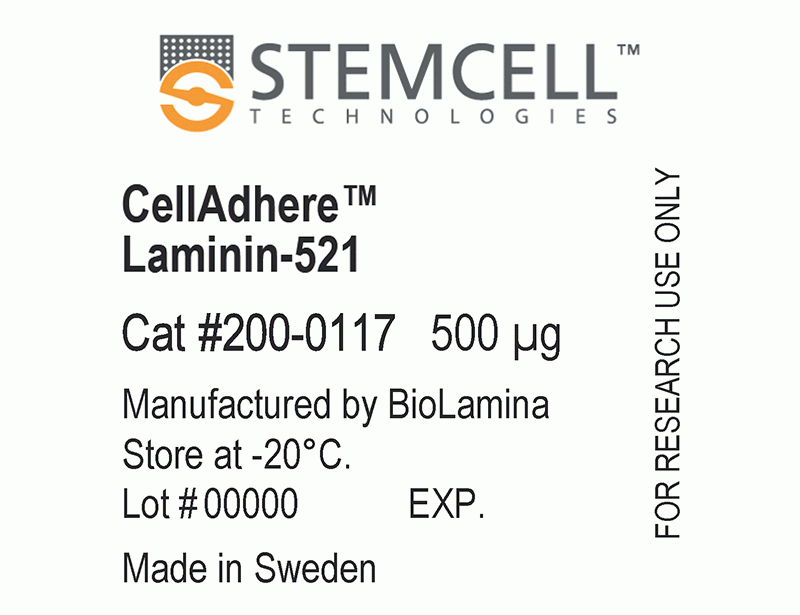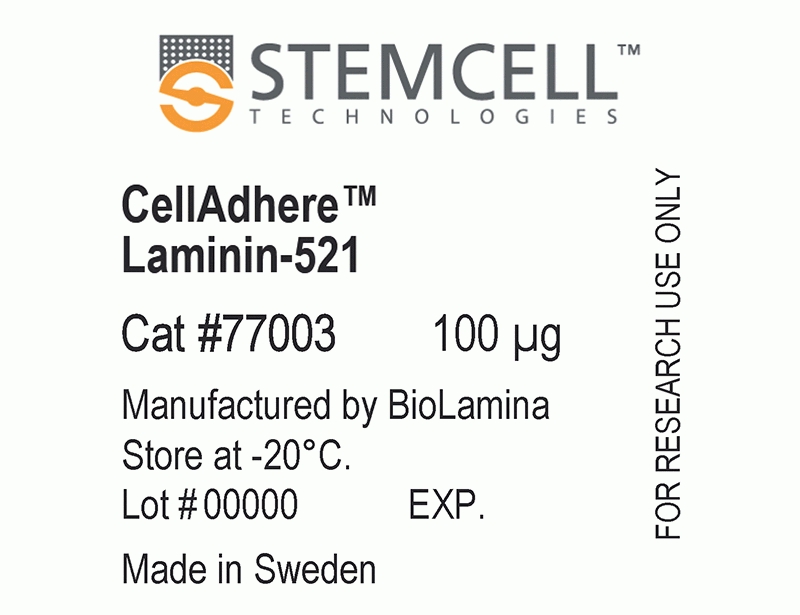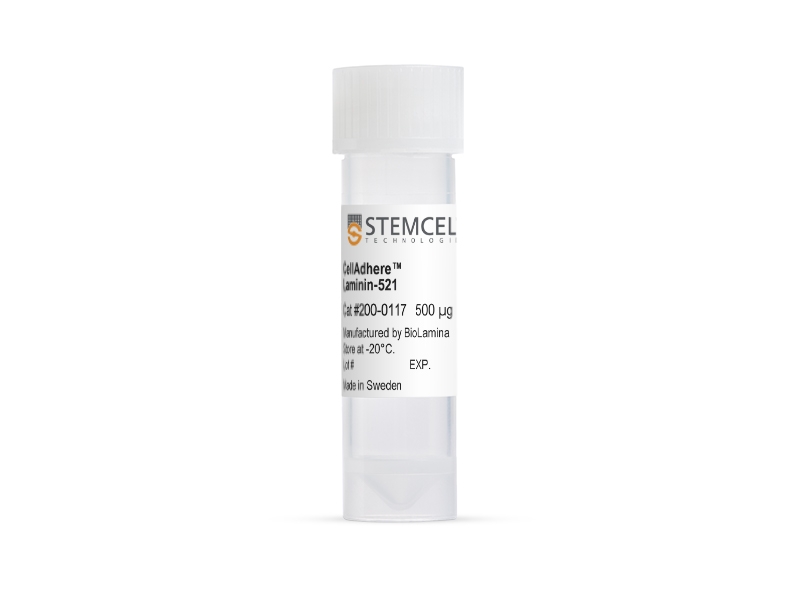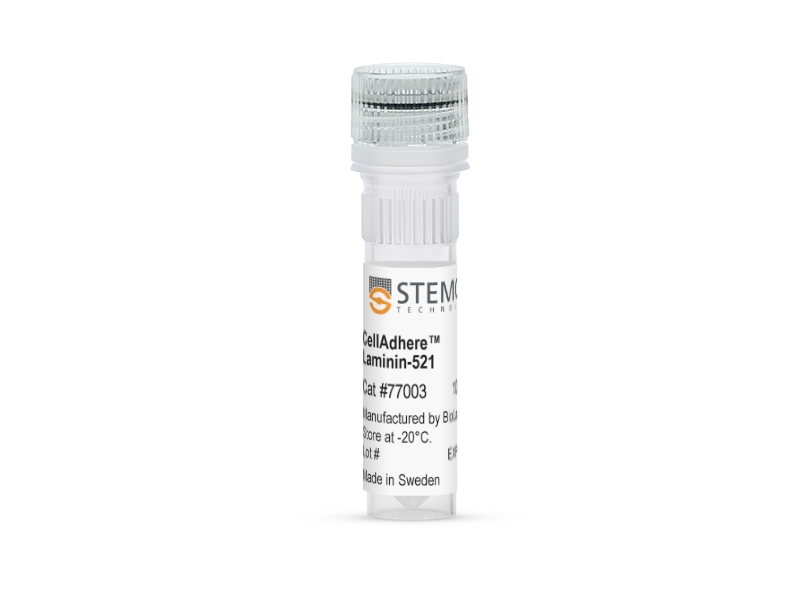概要
CellAdhere™ Laminin-521 is a defined, xeno-free cell culture matrix that supports the long-term maintenance of human embryonic stem (ES) cells and induced pluripotent stem (iPS) cells in feeder-free conditions. Using CellAdhere™ Laminin-521 as a cell culture matrix increases single-cell attachment and survival compared to other matrices and does not require the addition of apoptotic inhibitors during plating. (Lu HF et al.; Rodin S et al.; Rodin S et al.) When used with mTeSR™1 (Catalog #85850), mTeSR™ Plus (Catalog #05825), TeSR™2 (Catalog #05860) or TeSR™-E8™ (Catalog #05940), the system allows complete control over the culture environment, resulting in consistent cell populations and reproducible results in downstream applications.
NOTE: Although it is possible to passage human ES and iPS cells as single cells, this can result in selective pressure that could lead to genetic aberrations. (Draper JS et al.; The International Stem Cell Initiative; Garitaonandia I et al.) If passaging as single cells, check the karyotype frequently.
NOTE: Although it is possible to passage human ES and iPS cells as single cells, this can result in selective pressure that could lead to genetic aberrations. (Draper JS et al.; The International Stem Cell Initiative; Garitaonandia I et al.) If passaging as single cells, check the karyotype frequently.
技术资料
| Document Type | 产品名称 | Catalog # | Lot # | 语言 |
|---|---|---|---|---|
| Product Information Sheet | CellAdhere™ Laminin-521 | 77003, 77004, 200-0117 | All | English |
| Safety Data Sheet | CellAdhere™ Laminin-521 | 77003, 77004 | All | English |
| Safety Data Sheet | CellAdhere™ Laminin-521 | 200-0117 | All | English |
数据及文献
Publications (9)
Stem cell research {\&} therapy 2020 Rapid generation of purified human RPE from pluripotent stem cells using 2D cultures and lipoprotein uptake-based sorting
Abstract
Abstract
BACKGROUND: Despite increasing demand, current protocols for human pluripotent stem cell (hPSC)-derived retinal pigment epithelium (RPE) remain time, labor, and cost intensive. Additionally, absence of robust methods for selective RPE purification and removal of non-RPE cell impurities prevents upscaling of clinical quality RPE production. We aimed to address these challenges by developing a simplified hPSC-derived RPE production and purification system that yields high-quality RPE monolayers within 90 days. METHODS: Human pluripotent stem cells were differentiated into RPE using an innovative time and cost-effective protocol relying entirely on 2D cultures and minimal use of cytokines. Once RPE identity was obtained, cells were transferred onto permeable membranes to acquire mature RPE morphology. RPE differentiation was verified by electron microscopy, polarized VEGF expression, establishment of high transepithelial electrical resistance and photoreceptor phagocytosis assay. After 4 weeks on permeable membranes, RPE cell cultures were incubated with Dil-AcLDL (DiI-conjugated acetylated low-density lipoproteins) and subjected to fluorescence-activated cell sorting (FACS) for purification and subculture. RESULTS: Using our 2D cytokine scarce protocol, hPSC-derived functional RPE cells can be obtained within 2 months. Nevertheless, at this stage, most samples contain a percentage of non-RPE/early RPE progenitor cells that make them unsuitable for clinical application. We demonstrate that functional RPE cells express high levels of lipoprotein receptors and that this correlates with their ability to uptake lipoproteins. Combining photoreceptor uptake assay with lipoprotein uptake assay further confirms that only functional RPE cells uptake AcLDL. Incubation of mixed RPE/non-RPE cell cultures with fluorophore conjugated AcLDL and subsequent FACS-based isolation of labeled cells allows selective purification of mature functional RPE. When subcultured, DiI-AcLDL-labeled cells rapidly form pure homogenous high-quality RPE monolayers. CONCLUSIONS: Pure functional RPE monolayers can be derived from hPSC within 90 days using simplified 2D cultures in conjunction with our RPE PLUS protocol (RPE Purification by Lipoprotein Uptake-based Sorting). The simplicity of this protocol makes it scalable, and the rapidity of production and purification allows for high-quality RPE to be produced in a short span of time making them ideally suited for downstream clinical and in vitro applications.
Stem Cells and Development 2019 WNT inhibition and increased FGF signaling promotes derivation of less heterogeneous primed human embryonic stem cells, compatible with differentiation
Abstract
Abstract
Human embryonic stem cells (hESCs) hold great value for future clinical applications. However, standard culture conditions maintain hESCs in a primed state, which bears heterogeneity in pluripotency and a tendency for spontaneous differentiation. To counter these drawbacks, primed hESCs have been converted to a naive state, but this has restricted the efficiency of existing directed differentiation protocols. In mouse, WNT inhibition by inhibitor of WNT production-2, together with a higher dose of fibroblast growth factor 2 (12 ng/mL) in DMEM/F12 basal medium (DhiFI), markedly improved derivation and maintenance of primed mouse epiblast stem cells. In this study, we show that DhiFI conditions similarly improved primed hESC traits, such as conferring a primed transcriptional signature with high levels of pluripotency markers and reduced levels of differentiation markers. When triggered to differentiate to neuronal and cardiac lineages, DhiFI hESCs and isogenic primed hESCs progressed similarly. Moreover, DhiFI conditions supported the derivation of hESC lines from a post-inner cell mass intermediate (PICMI). DhiFI-derived hESCs showed less spontaneous differentiation and expressed significantly lower levels of lineage-specific markers, compared to primed-derived lines from the same PICMI. Overall, DhiFI hESCs retained advantages of both primed and naive pluripotency and may ultimately represent a more favorable starting point for differentiation toward clinically desired cell types.
Cell 2018 Chromosome Segregation Fidelity in Epithelia Requires Tissue Architecture
Abstract
Abstract
Much of our understanding of chromosome segregation is based on cell culture systems. Here, we examine the importance of the tissue environment for chromosome segregation by comparing chromosome segregation fidelity across several primary cell types in native and nonnative contexts. We discover that epithelial cells have increased chromosome missegregation outside of their native tissues. Using organoid culture systems, we show that tissue architecture, specifically integrin function, is required for accurate chromosome segregation. We find that tissue architecture enhances the correction of merotelic microtubule-kinetochore attachments, and this is especially important for maintaining chromosome stability in the polyploid liver. We propose that disruption of tissue architecture could underlie the widespread chromosome instability across epithelial cancers. Moreover, our findings highlight the extent to which extracellular context can influence intrinsic cellular processes and the limitations of cell culture systems for studying cells that naturally function within a tissue. Tissue architecture and integrin function are critical factors that support chromosome segregation fidelity in epithelial tissues.
PloS one 2015 Increased risk of genetic and epigenetic instability in human embryonic stem cells associated with specific culture conditions.
Abstract
Abstract
The self-renewal and differentiation capacities of human pluripotent stem cells (hPSCs) make them a promising source of material for cell transplantation therapy, drug development, and studies of cellular differentiation and development. However, the large numbers of cells necessary for many of these applications require extensive expansion of hPSC cultures, a process that has been associated with genetic and epigenetic alterations. We have performed a combinatorial study on both hESCs and hiPSCs to compare the effects of enzymatic vs. mechanical passaging, and feeder-free vs. mouse embryonic fibroblast feeder substrate, on the genetic and epigenetic stability and the phenotypic characteristics of hPSCs. In extensive experiments involving over 100 continuous passages, we observed that both enzymatic passaging and feeder-free culture were associated with genetic instability, higher rates of cell proliferation, and persistence of OCT4/POU5F1-positive cells in teratomas, with enzymatic passaging having the stronger effect. In all combinations of culture conditions except for mechanical passaging on feeder layers, we noted recurrent deletions in the genomic region containing the tumor suppressor gene TP53, which was associated with decreased mRNA expression of TP53, as well as alterations in the expression of several downstream genes consistent with a decrease in the activity of the TP53 pathway. Among the hESC cultures, we also observed culture-associated variations in global gene expression and DNA methylation. The effects of enzymatic passaging and feeder-free conditions were also observed in hiPSC cultures. Our results highlight the need for careful assessment of the effects of culture conditions on cells intended for clinical therapies.
Nature protocols 2014 OCT Monolayer culturing and cloning of human pluripotent stem cells on laminin-521-based matrices under xeno-free and chemically defined conditions.
Abstract
Abstract
A robust method for culturing human pluripotent stem (hPS) cells under chemically defined and xeno-free conditions is an important tool for stem cell research and for the development of regenerative medicine. Here, we describe a protocol for monolayer culturing of Oct-4-positive hPS cells on a specific laminin-521 (LN-521) isoform, under xeno-free and chemically defined conditions. The cells are dispersed into single-cell suspension and then plated on LN-521 isoform at densities higher than 5,000 cells per cm², where they attach, migrate and survive by forming small monolayer cell groups. The cells avidly divide and expand horizontally until the entire dish is covered by a confluent monolayer. LN-521, in combination with E-cadherin, allows cloning of individual hPS cells in separate wells of 96-well plates without the presence of rho-associated protein kinase (ROCK) inhibitors or any other inhibitors of anoikis. Characterization of cells maintained for several months in culture reveals pluripotency with a minimal degree of genetic abnormalities.
Biomaterials 2014 MAR A defined xeno-free and feeder-free culture system for the derivation, expansion and direct differentiation of transgene-free patient-specific induced pluripotent stem cells
Abstract
Abstract
A defined xeno-free system for patient-specific iPSC derivation and differentiation is required for translation to clinical applications. However, standard somatic cell reprogramming protocols rely on using MEFs and xenogeneic medium, imposing a significant obstacle to clinical translation. Here, we describe a well-defined culture system based on xeno-free media and LN521 substrate which supported i) efficient reprogramming of normal or diseased skin fibroblasts from human of different ages into hiPSCs with a 15-30 fold increase in efficiency over conventional viral vector-based method; ii) long-term self-renewal of hiPSCs; and iii) direct hiPSC lineage-specific differentiation. Using an excisable polycistronic vector and optimized culture conditions, we achieved up to 0.15%-0.3% reprogramming efficiencies. Subsequently, transgene-free hiPSCs were obtained by Cre-mediated excision of the reprogramming factors. The derived iPSCs maintained long-term self-renewal, normal karyotype and pluripotency, as demonstrated by the expression of stem cell markers and ability to form derivatives of three germ layers both in vitro and in vivo. Importantly, we demonstrated that Parkinson's patient transgene-free iPSCs derived using the same system could be directed towards differentiation into dopaminergic neurons under xeno-free culture conditions. Our approach provides a safe and robust platform for the generation of patient-specific iPSCs and derivatives for clinical and translational applications. textcopyright 2013 Elsevier Ltd.

 网站首页
网站首页





